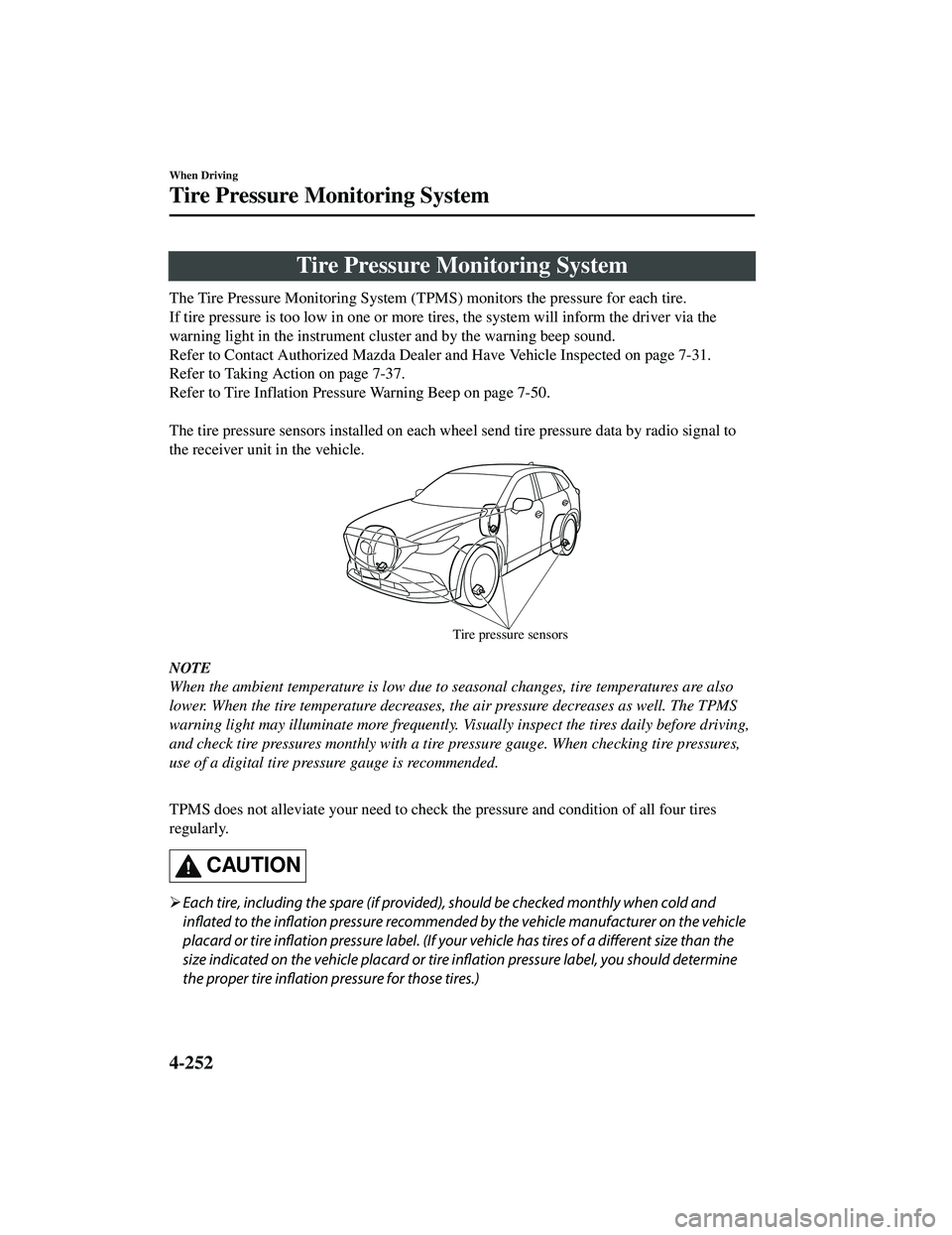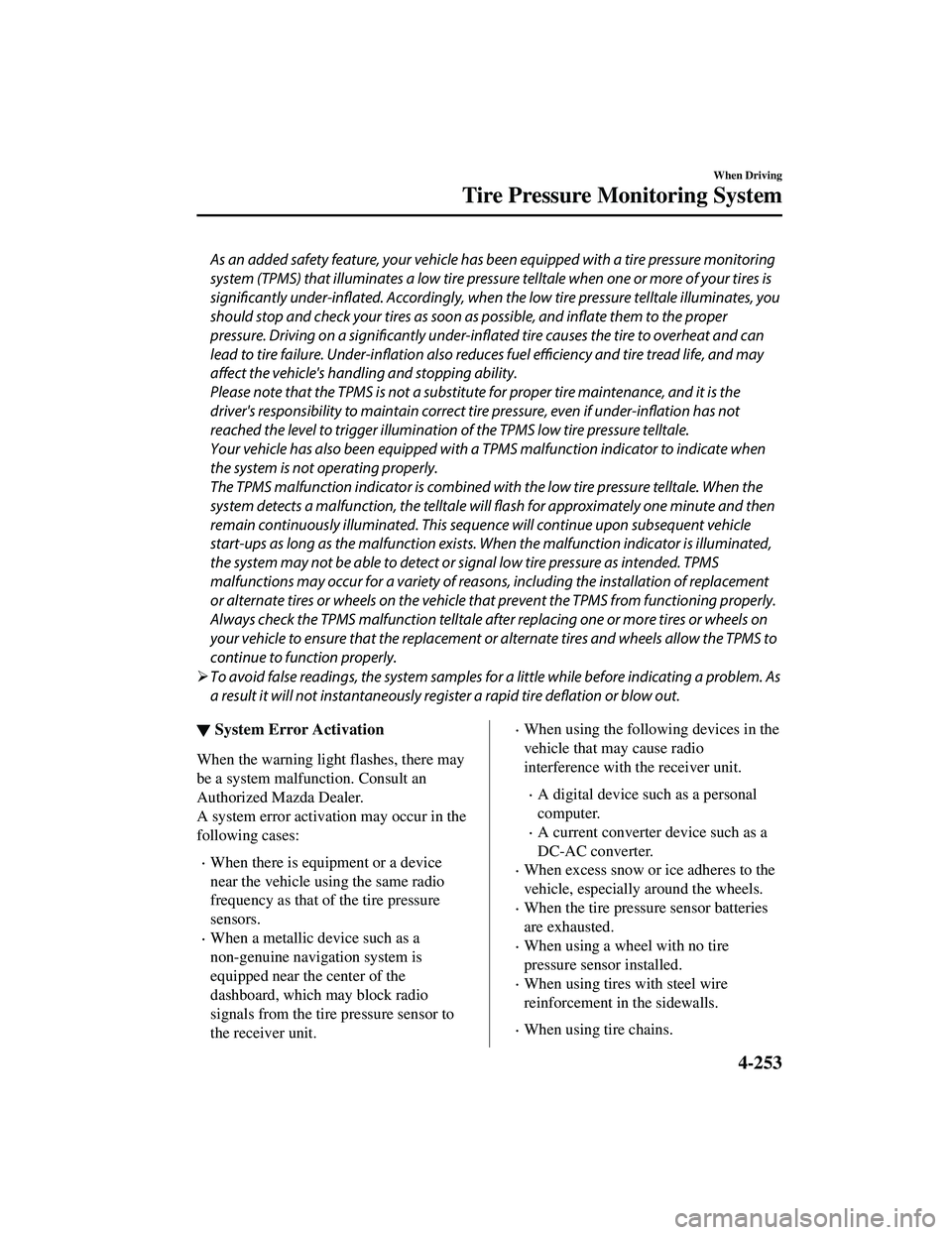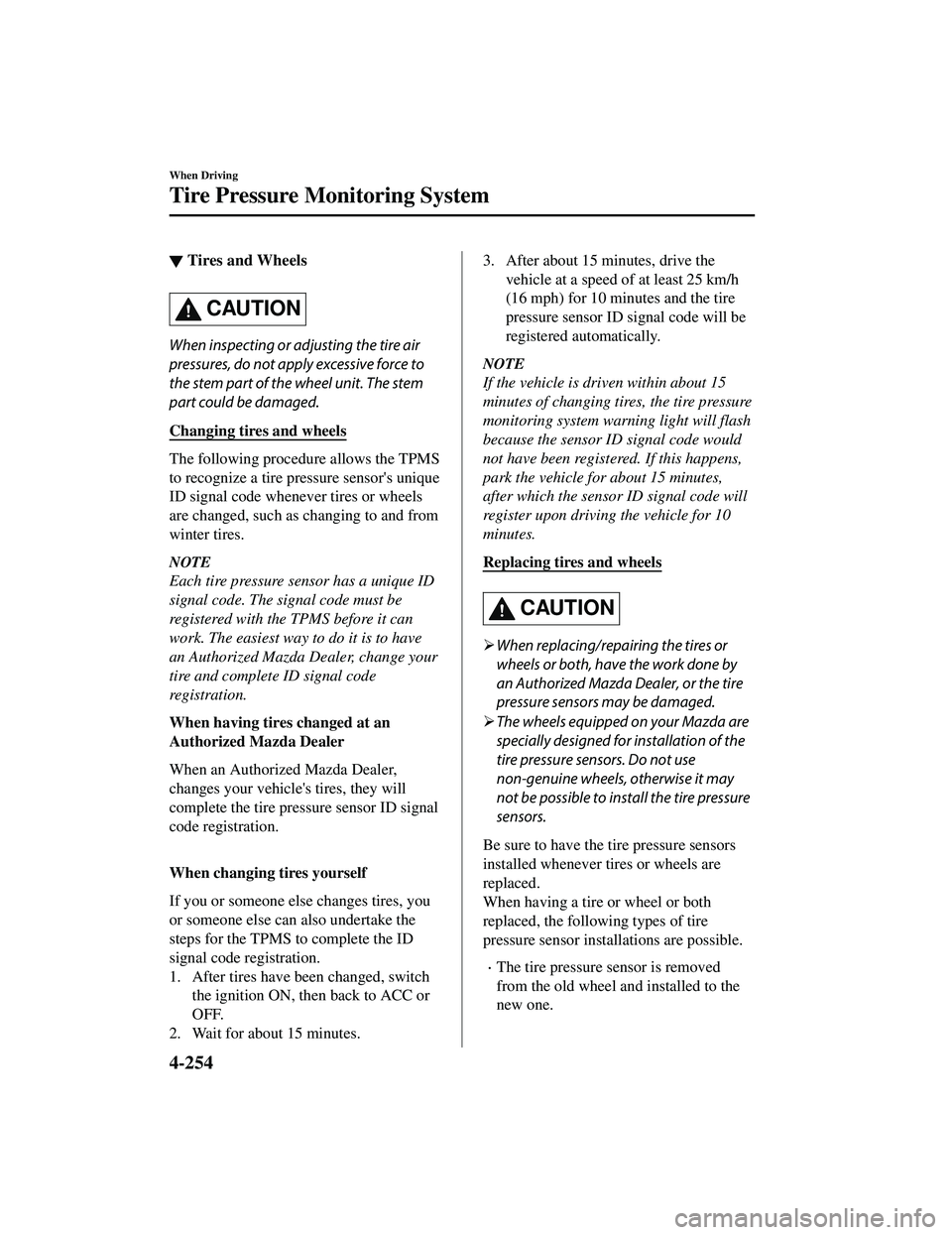sensor MAZDA MODEL CX-9 2021 Manual PDF
[x] Cancel search | Manufacturer: MAZDA, Model Year: 2021, Model line: MODEL CX-9, Model: MAZDA MODEL CX-9 2021Pages: 723, PDF Size: 10.61 MB
Page 413 of 723

’éĘVehicle shapes which do not reflect radar waves well such as empty trailers with a low
vehicle height and sports cars.
’éĘVehicles are shipped with the direction of the radar sensors (rear) adjusted for each
vehicle to a loaded vehicle condition so that the radar sensors (rear) detect approaching
vehicles correctly. If the direction of the radar sensors (rear) has deviated for some
reason, have the vehicle inspected at an Authorized Mazda Dealer.
’éĘFor repairs or replacement of the radar sensors (rear), or bumper repairs, paintwork, and
replacement near the radar sensors, consult an Authorized Mazda Dealer.
’éĘTurn off the system while pulling a trailer or while an accessory such as a bicycle carrier
is installed to the rear of the vehicle. Otherwise, the radio waves emitted by the radar will
be blocked causing the system to not operate normally.
’éĘThe radar sensors are regulated by the relevant radio wave laws of the country in which
the vehicle is driven. If the vehicle is driven abroad, authorization from the country in
which the vehicle is driven may be required.
When Driving
i-ACTIVSENSE
4-244
CX-9_8JK1-EA-20G_Edition6_old 2021-12-8 9:30:44
Page 414 of 723

Ultrasonic Sensor (Rear)*
The ultrasonic sensors (rear) function by emitting ultrasonic waves which are reflected off
obstructions at the rear and the returning ultrasonic waves are picked up by the ultrasonic
sensors (rear).
Ultrasonic sensor (rear)
The ultrasonic sensors (rear) are mounted in the rear bumper.
When Driving
i-ACTIVSENSE
*Some models.4-245
CX-9_8JK1-EA-20G_Edition6_old2021-12-8 9:30:44
Page 421 of 723

Tire Pressure Monitoring System
The Tire Pressure Monitoring System (TPMS) monitors the pressure for each tire.
If tire pressure is too low in one or more tires, the system will inform the driver via the
warning light in the instrument cluster and by the warning beep sound.
Refer to Contact Authorized Mazda Dealer and Have Vehicle Inspected on page 7-31.
Refer to Taking Action on page 7-37.
Refer to Tire Inflation Pressure Warning Beep on page 7-50.
The tire pressure sensors installed on each wheel send tire pressure data by radio signal to
the receiver unit in the vehicle.
Tire pressure sensors
NOTE
When the ambient temperature is low due to seasonal changes, tire temperatures are also
lower. When the tire temperature decreases, the air pressure decreases as well. The TPMS
warning light may illumina te more frequently. Visually inspect the tires daily before driving,
and check tire pressures monthly with a tire pressure gauge. When checking tire pressures,
use of a digital tire pressure gauge is recommended.
TPMS does not alleviate your need to check the pressure and condition of all four tires
regularly.
CAUTION
’āś Each tire, including the spare (if provided), should be checked monthly when cold and
inflated to the inflation pressure recommended by the vehicle manufacturer on the vehicle
placard or tire inflation pressure label. (If your vehicle has tires of a different size than the
size indicated on the vehicle placard or tire inflation pressure label, you should determine
the proper tire inflation pressure for those tires.)
When Driving
Tire Pressure Monitoring System
4-252
CX-9_8JK1-EA-20G_Edition6_old 2021-12-8 9:30:44
Page 422 of 723

As an added safety feature, your vehicle has been equipped with a tire pressure monitoring
system (TPMS) that illuminates a low tire pre ssure telltale when one or more of your tires is
significantly under-inflated. Accordingly, when th e low tire pressure telltale illuminates, you
should stop and check your tires as soon as possible, and inflate them to the proper
pressure. Driving on a significantly under-in flated tire causes the tire to overheat and can
lead to tire failure. Under-inflation also reduce s fuel efficiency and tire tread life, and may
affect the vehicle's handling and stopping ability.
Please note that the TPMS is not a substitute for proper tire maintenance, and it is the
driver's responsibility to maintain correct ti re pressure, even if under-inflation has not
reached the level to trigger illumination of the TPMS low tire pressure telltale.
Your vehicle has also been equipped with a TPMS malfunction indicator to indicate when
the system is not operating properly.
The TPMS malfunction indicator is combined with the low tire pressure telltale. When the
system detects a malfunction, the telltale wi ll flash for approximately one minute and then
remain continuously illuminated. This sequen ce will continue upon subsequent vehicle
start-ups as long as the malfunction exists. When the malfunction indicator is illuminated,
the system may not be able to detect or signal low tire pressure as intended. TPMS
malfunctions may occur for a variety of reasons, including the installation of replacement
or alternate tires or wheels on the vehicle th at prevent the TPMS from functioning properly.
Always check the TPMS malfunction telltale after replacing one or more tires or wheels on
your vehicle to ensure that the replacement or alternate tires and wheels allow the TPMS to
continue to function properly.
’āś To avoid false readings, the system samples fo r a little while before indicating a problem. As
a result it will not instantaneously regi ster a rapid tire deflation or blow out.
Ō¢╝System Error Activation
When the warning light flashes, there may
be a system malfunction. Consult an
Authorized Mazda Dealer.
A system error activation may occur in the
following cases:
’éĘWhen there is equipment or a device
near the vehicle using the same radio
frequency as that of the tire pressure
sensors.
’éĘWhen a metallic device such as a
non-genuine navigation system is
equipped near the center of the
dashboard, which may block radio
signals from the tire pressure sensor to
the receiver unit.
’éĘWhen using the following devices in the
vehicle that may cause radio
interference with the receiver unit.
’éĘA digital device such as a personal
computer.
’éĘA current converter device such as a
DC-AC converter.
’éĘWhen excess snow or ice adheres to the
vehicle, especially around the wheels.
’éĘWhen the tire pressure sensor batteries
are exhausted.
’éĘWhen using a wheel with no tire
pressure sensor installed.
’éĘWhen using tires with steel wire
reinforcement in
the sidewalls.
’éĘWhen using tire chains.
When Driving
Tire Pressure Monitoring System
4-253
CX-9_8JK1-EA-20G_Edition6_old 2021-12-8 9:30:44
Page 423 of 723

Ō¢╝Tires and Wheels
CAUTION
When inspecting or adjusting the tire air
pressures, do not apply excessive force to
the stem part of the wheel unit. The stem
part could be damaged.
Changing tires and wheels
The following proced
ure allows the TPMS
to recognize a tire pressure sensor's unique
ID signal code whenever tires or wheels
are changed, such as changing to and from
winter tires.
NOTE
Each tire pressure sensor has a unique ID
signal code. The signal code must be
registered with the TPMS before it can
work. The easiest way to do it is to have
an Authorized Mazda Dealer, change your
tire and complete ID signal code
registration.
When having tires changed at an
Authorized Mazda Dealer
When an Authorized Mazda Dealer,
changes your vehicle's tires, they will
complete the tire pressure sensor ID signal
code registration.
When changing tires yourself
If you or someone else changes tires, you
or someone else can also undertake the
steps for the TPMS to complete the ID
signal code registration.
1. After tires have been changed, switch the ignition ON, th en back to ACC or
OFF.
2. Wait for about 15 minutes.
3. After about 15 minutes, drive the
vehicle at a speed of at least 25 km/h
(16 mph) for 10 minutes and the tire
pressure sensor ID signal code will be
registered automatically.
NOTE
If the vehicle is driven within about 15
minutes of changing tires, the tire pressure
monitoring system warn ing light will flash
because the sensor ID signal code would
not have been registered. If this happens,
park the vehicle for about 15 minutes,
after which the sensor ID signal code will
register upon driving the vehicle for 10
minutes.
Replacing tires and wheels
CAUTION
’āś When replacing/repairing the tires or
wheels or both, have the work done by
an Authorized Mazda Dealer, or the tire
pressure sensors may be damaged.
’āś The wheels equipped on your Mazda are
specially designed for installation of the
tire pressure sensors. Do not use
non-genuine wheels, otherwise it may
not be possible to inst all the tire pressure
sensors.
Be sure to have the tire pressure sensors
installed whenever tires or wheels are
replaced.
When having a tire or wheel or both
replaced, the following types of tire
pressure sensor installations are possible.
’éĘThe tire pressure sensor is removed
from the old wheel an d installed to the
new one.
When Driving
Tire Pressure Monitoring System
4-254
CX-9_8JK1-EA-20G_Edition6_old 2021-12-8 9:30:44
Page 424 of 723

’éĘThe same tire pressure sensor is used
with the same wheel. Only the tire is
replaced.
’éĘA new tire pressure sensor is installed to
a new wheel.
NOTE
’éĘThe tire pressure sensor ID signal code
must be registered when a new tire
pressure sensor is purchased. For
purchase of a tire pressure sensor and
registration of the tire pressure sensor
ID signal code, consult an Authorized
Mazda Dealer.
’éĘWhen reinstalling a previously removed
tire pressure sensor to a wheel, replace
the grommet (seal between valve body/
sensor and wheel) for the tire pressure
sensor.
When Driving
Tire Pressure Monitoring System
4-255
CX-9_8JK1-EA-20G_Edition6_old 2021-12-8 9:30:44
Page 427 of 723

Ō¢╝Displayable Range on the Screen
The images on the screen may be different from the actual conditions.
(Screen display)
Garnish
Bumper
(Actual view)
Object
Obstruction detection
indication in parking
sensor system
Some models
NOTE
’éĘThe displayable range varies depending on the vehicle and road conditions.
’éĘThe displayable range is limited. Objects under the bumper or around the bumper ends
cannot be displayed.
’éĘThe distance appearing in the displayed image is different from the actual distance
because the rear view parking camera is equipped with a specific lens.
’éĘSome optionally installed vehicle accessories may be picked up by the camera. Do not
install any optional part s that can interfere with the camera view, such as illuminating
parts or parts made of reflective material.
’éĘIt may be difficult to see the display under the following conditions, however, it does not
indicate a malfunction.
’éĘIn darkened areas.
’éĘWhen the temperature around the lens is high/low.
’éĘWhen the camera is wet such as on a rainy day or during periods of high humidity.
’éĘWhen foreign material such as mud is stuck around the camera.
’éĘWhen the camera lens reflects sunlight or headlight beams.
’éĘImage display may be delayed if the temperature around the camera is low.
When Driving
Rear View Monitor (Maz da Connect (Type A))
4-258
CX-9_8JK1-EA-20G_Edition6_old 2021-12-8 9:30:44
Page 441 of 723

Parking Sensor System (Mazda Connect (Type A))*
The parking sensors use ultrasonic sensors which detect obstructions around the vehicle
when the vehicle is driven at low speeds, such as during garage or parallel parking, and a
buzzer sound and detection indicator notify the driver of the approximate distance from the
vehicle to the surrounding obstruction.
Rear corner ultrasonic sensor
Front corner ultrasonic sensor
Rear ultrasonic
sensor
Front ultrasonic sensorSome models.
WA R N I N G
Do not rely completely on the parking sensor system and be sure to confirm the safety around
your vehicle visually when driving:
This system can assist the driver in opera ting the vehicle in the forward and backward
directions while parking. The detection ranges of the sensors are limited, therefore, driving the
vehicle while relying only on the system may cause an accident. Always confirm the safety
around your vehicle visually when driving.
NOTE
’éĘDo not install any accessories within the detection ranges of the sensors. It may affect the
system operation.
’éĘDepending on the type of obstruction and th e surrounding conditions, the detection range
of a sensor may narrow, or the sensors may not be able to detect obstructions.
’éĘThe system may not operate norma lly under the following conditions:
’éĘMud, ice, or snow is adhering to the sensor area (Returns to normal operation when
removed).
’éĘThe sensor area is frozen (Returns to normal operation when the ice is thawed).
’éĘThe sensor is covered by a hand.
’éĘThe sensor is excessively shocked.
’éĘThe vehicle is excessively tilted.
When Driving
Parking Sensor System (Mazda Connect (Type A))
4-272*Some models.
CX-9_8JK1-EA-20G_Edition6_old 2021-12-8 9:30:44
Page 442 of 723

’éĘUnder extremely hot or cold weather conditions.
’éĘThe vehicle is driven on bumps, inclines, gravel, or grass covered roads.
’éĘAnything which generates ultrasound is near the vehicle, such as another vehicle's
horn, the engine sound of a motorcycle, the air brake sound of a large-sized vehicle, or
another vehicle's sensors.
’éĘThe vehicle is driven in heavy rain or in road conditions causing water-splash.
’éĘA commercially-available fender pole or an antenna for a radio transmitter is installed
to the vehicle.
’éĘThe vehicle is moving towards a tall or square curbstone.
’éĘAn obstruction is too close to the sensor.
’éĘObstructions under the bumper may not be detected. Obstructions that are lower than the
bumper or thin which may have been initially detected may no longer be detected as the
vehicle approaches more closely to the obstruction.
’éĘThe following types of obstructions may not be detected:
’éĘThin objects such as wire or rope
’éĘThings which absorb sonic waves easily such as cotton or snow
’éĘAngular shaped objects
’éĘVery tall objects, and those which are wide at the top
’éĘSmall, short objects
’éĘAlways have the system inspected at an Authorized Mazda Dealer if any shock is applied
to the bumpers, even in a minor accident. If the sensors are deviated, they cannot detect
obstructions.
’éĘ(With front ultrasonic sensor and front ultrasonic corner sensor)
The system may have a malfunction if the beep does not operate or the indicator light
does not illuminate when the parking sensor switch is turned on. Consult an Authorized
Mazda Dealer.
’éĘ(Without front ultrasonic sensor and front ultrasonic corner sensor)
The system may have a malfunction if the be ep does not operate. Consult an Authorized
Mazda Dealer.
’éĘ(With front ultrasonic sensor and front ultrasonic corner sensor)
The system may have a malfunction if the beep sound which indicates a system
malfunction is heard and the i ndicator light flashes. Consult an Authorized Mazda Dealer.
’éĘThe beeper which indicates a system malf unction may not be heard if the ambient
temperature is extremely cold, or mud, ice, or snow adheres to the sensor area. Remove
any foreign material from the sensor area.
’éĘWhen installing a trailer hitch, consult an Authorized Mazda Dealer.
When Driving
Parking Sensor System (M azda Connect (Type A))
4-273
CX-9_8JK1-EA-20G_Edition6_old 2021-12-8 9:30:44
Page 443 of 723

Ō¢╝Sensor Detection Range
The sensors detect obstructio
ns within the following range.
Front ultrasonic sensor detection range
Front corner ultrasonic sensor detection range Rear ultrasonic sensor detection range
Rear corner ultrasonic sensor detection range
B
A
D
C A: About 55 cm (About 21.6 in)
B: About 55 cm (About 21.6 in)
C: About 100 cm (About 39.3 in)
D: About 150 cm (About 59.0 in)
Viewing distance display
Display
Distance between vehicle and obstruction
Without 360┬░ view monitor
With 360┬░ viewmonitor Front ultrasonic sen
ŌĆÉ
sor
*/Front corner
ultrasonic sensor*
Rear ultrasonic sen ŌĆÉ
sor/Rear Corner ul ŌĆÉ
trasonic sensor
Without front ul
ŌĆÉ
trasonic sensor and front corner ultra ŌĆÉ
sonic sensor With front ultra
ŌĆÉ
sonic sensor and
front corner ultra ŌĆÉ
sonic sensor
Green
Front ultrasonic sen ŌĆÉ
sor:
Approx. 100 ŌĆĢ60 cm
(39.3ŌĆĢ 23.6 in) Rear ultrasonic sen
ŌĆÉ
sor:
Approx. 150 ŌĆĢ60 cm
(59.0ŌĆĢ 23.6 in)
When Driving
Parking Sensor System (M azda Connect (Type A))
4-274*Some models.
CX-9_8JK1-EA-20G_Edition6_old 2021-12-8 9:30:44